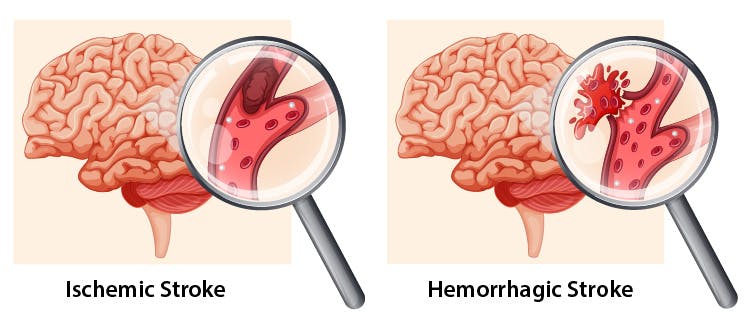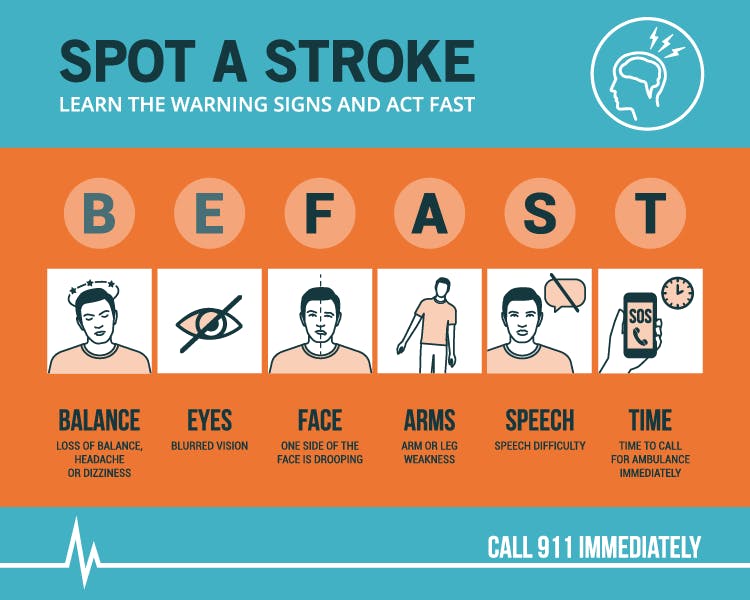I used to say stroke, then aneurysm for variety, but the more I heard people talking about one or the other, I realized that I had made a mistake. So to have my dear readers not make the same mistake, an aneurysm is different from a stroke, yet commonalities exist.
Flint Rehab says, "The big difference is that a stroke is an event and an aneurysm is a condition." That didn't make sense to me because you can have multiple strokes and then that would be a condition. But the pictures from Flint tell all you would need to know.

A stroke occurs when the supply of blood in the brain is blocked by either a clogged artery (ischemic stroke) or burst artery (hemorrhagic stroke).
When a stroke occurs, it deprives brain cells of oxygen-rich blood (https://stroketales.blogspot.com/2019/06/oxygen-getting-to-brain-cells-is.html) and leads to brain damage. As a result, a stroke can result in massive or minor symptoms and requires immediate medical attention!

A saccular aneurysms – also known as “berry aneurysms” – involves a large bulge in an artery that resembles a berry hanging off a branch.
A fusiform aneurysms involves the artery bulging in all directions.
You can have an aneurysm without any symptoms. However, once an aneurysm in the brain ruptures, it leads to a hemorrhagic stroke (the commonality between stroke and aneurysm), which is likely where the confusion between the two conditions occur.
Although an aneurysm can occur in the abdomen or chest, I am talking about cerebral aneurysm which occurs in the brain.

According to the Mayo Clinic, symptoms of an unruptured brain aneurysm are varied:
Here’s the main difference between how a stroke and an aneurysm differ:
When a large berry aneurysm is found in the brain, doctors may recommend an aneurysm clipping, where a tiny metal clip is surgically placed to isolate the aneurysm and prevent rupturing.
Coil embolization
Endovascular flow diversion
When an aneurysm isn’t accessible or too damaged, a bypass may be performed. During this surgery, tiny metal clips are used to completely block flow from the artery. The blood flow is then rerouted via vessel grafting by taking an artery from somewhere else and adding it to the problem area.
Treatment for a ruptured brain aneurysm, that is, a hemorrhagic stroke:
A ruptured brain aneurysm which is a hemorrhagic stroke is usually treated with a craniotomy, where a surgeon removes part of the skull and clips the ruptured artery to stop the bleeding. Once the aneurysm is treated and normal blood flow is restored in the brain, stroke rehabilitation can begin to recover from the side effects caused by a brain bleed.
And this from the Mayo Clinic. Most brain aneurysms, however, don't rupture, create health problems or cause symptoms. Such aneurysms are often detected during tests for other conditions.
Oh, great. Another thing to worry about: an undetected, unruptured brain aneurysm with no symptoms.
I'm suddenly reminded of what Julius Caesar once said: "As a rule, men worry more about what they can't see than about what they can."
You got that right, Julius!
Flint Rehab says, "The big difference is that a stroke is an event and an aneurysm is a condition." That didn't make sense to me because you can have multiple strokes and then that would be a condition. But the pictures from Flint tell all you would need to know.
Explaining a stroke:

A stroke occurs when the supply of blood in the brain is blocked by either a clogged artery (ischemic stroke) or burst artery (hemorrhagic stroke).
When a stroke occurs, it deprives brain cells of oxygen-rich blood (https://stroketales.blogspot.com/2019/06/oxygen-getting-to-brain-cells-is.html) and leads to brain damage. As a result, a stroke can result in massive or minor symptoms and requires immediate medical attention!
Explaining in aneurysm:

A saccular aneurysms – also known as “berry aneurysms” – involves a large bulge in an artery that resembles a berry hanging off a branch.
A fusiform aneurysms involves the artery bulging in all directions.
Although an aneurysm can occur in the abdomen or chest, I am talking about cerebral aneurysm which occurs in the brain.
A stroke requires immediate attention.

The aneurysm is different because unruptured brain aneurysm doesn’t usually cause any symptoms. But if the aneurysm grows larger or ruptures, then symptoms occur.
According to the Mayo Clinic, symptoms of an unruptured brain aneurysm are varied:
- Dizziness
- Mild or severe headache
- Blurred or double vision
- Seizures
- Older age
- Cigarette smoking
- High blood pressure (hypertension)
- Drug abuse, particularly the use of cocaine
- Heavy alcohol consumption
Sometimes, a brain aneurysm can leak a small amount of blood, which is called a sentinel bleed which results in the worst headache ever. Emergency medical attention is needed because it often leads to a severe rupture.
An aneurysm rupture can mean bleeding into the brain, thus a hemorrhagic stroke. It's called a subarachnoid hemorrhage, the symptoms of which are:
- Drooping eyelids
- Loss of consciousness
- Sudden, severe headache
- Neck stiffness
- Blurry or double vision
- Sensitivity to light
- Seizures
- Nausea or vomiting
Treatment for stroke and aneurysm are different, but there is some overlap.
Here’s the main difference between how a stroke and an aneurysm differ:
- When a stroke is caused by a blood clot, that is, ischemic stroke, treatment usually involves a clot-dissolving drug called tPA or surgery to remove the clot.
- When stroke is caused by a burst artery, that is, hemorrhagic stroke, treatment often involves surgery.
- While small aneurysms are often benign and left alone, large aneurysm are often surgically treated in order to prevent rupturing.
Four different options for unruptured brain aneurysms are:
Aneurysm clipping
When a large berry aneurysm is found in the brain, doctors may recommend an aneurysm clipping, where a tiny metal clip is surgically placed to isolate the aneurysm and prevent rupturing.
Endovascular flow diversion
When a clipping or coiling won’t suffice, an endovascular flow diversion may be implemented. During this surgery, a tightly woven mesh tube is inserted into the artery to prevent blood from entering the aneurysm.
Artery occlusion and bypassWhen an aneurysm isn’t accessible or too damaged, a bypass may be performed. During this surgery, tiny metal clips are used to completely block flow from the artery. The blood flow is then rerouted via vessel grafting by taking an artery from somewhere else and adding it to the problem area.
Treatment for a ruptured brain aneurysm, that is, a hemorrhagic stroke:
A ruptured brain aneurysm which is a hemorrhagic stroke is usually treated with a craniotomy, where a surgeon removes part of the skull and clips the ruptured artery to stop the bleeding. Once the aneurysm is treated and normal blood flow is restored in the brain, stroke rehabilitation can begin to recover from the side effects caused by a brain bleed.
And this from the Mayo Clinic. Most brain aneurysms, however, don't rupture, create health problems or cause symptoms. Such aneurysms are often detected during tests for other conditions.
Oh, great. Another thing to worry about: an undetected, unruptured brain aneurysm with no symptoms.
I'm suddenly reminded of what Julius Caesar once said: "As a rule, men worry more about what they can't see than about what they can."
You got that right, Julius!

No comments:
Post a Comment